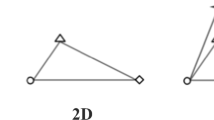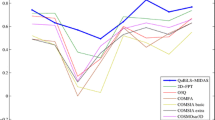Abstract
In this work, a hierarchic system of QSAR models from 1D to 4D is considered on the basis of the simplex representation of molecular structure (SiRMS). The essence of this system is that the QSAR problem is solved sequentially in a series of the improved models of the description of molecular structure. Thus, at each subsequent stage of a hierarchic system, the QSAR problem is not solved ab ovo, but rather the information obtained from the previous step is used. Actually, we deal with a system of solutions defined more exactly. In the SiRMS approach, a molecule is represented as a system of different simplex descriptors (tetratomic fragments with fixed composition, structure, chirality and symmetry). The level of simplex-descriptor detail increases consecutively from 1D to 4D representations of molecular structure. It enables us to determine the fragments of structure that promote or interfere with the given biological activity easily. Molecular design of compounds with a given level of activity is possible on the basis of SiRMS. The efficiency of the method is demonstrated for the example of the analysis of substituted piperazines affinity for the 5-HT1A receptor.
Figure Hierarchical technology of solving QSAR and Drug Design tasks.







Similar content being viewed by others
References
Cramer RD, Patterson DE, Bunce JD (1988) J Am Chem Soc 110:5959–5967
Seel M, Turner DB, Wilett P (1999) QSAR 18:245–252
Doweyko AM (1988) J Math Chem 31:1396–1406
Kuz’min VE, Artemenko AG, Kovdienko NA, Tetko IV, Livingstone DJ (2000) J Mol Model 6:517–526
Vedani A, Dobler M (2000) Prog Drug Res 55:107–135
Suchachev DV, Pivina TS, Shliapochnikov VA, Petrov EA, Paliulin VA, Zefirov NS (1993) Dokl RAN (in Russian) 328:50–57
Kuz’min VE (1994) Zh Phys Khim (in Russian) 68:1037–1043
Kuz’min VE (1995) Zh Strucur Khim (in Russian) 36:871–878
Kuz’min VE, Chelombitko VA, Yudanova IV (1998) Zh Structur Khim (in Russian) 39:549–554
Kuz’min VE, Artemenko AG, Lozitsky VP, Muratov EN, Fedtchouk AS, Dyachenko NS, Nosach LN, Gridina TL, Shitikova LI, Mudrik LM, Chelombitko VA, Zheltvay AI, Vanden Eynde JJ (2002) Acta Biochim Pol 49:157–168
Basak SC, Gute BD, Grunwald GD (1997) J Chem Inf Comput Sci 37:651–655
Jolly WL, Perry WB (1973) J Am Chem Soc 95:5442–5450
Renxiao W, Ying Fu, Luhua L (1997) J Chem Inf Comput Sci 37:615–621
Burkert U, Allinger NI (1982) Molecular mechanics. ACS, Washington DC
Rännar S, Lindgren F, Geladi P, Wold S (1994) J Chemometrics 8:111–125
Ferster E, Renz B (1979) Methoden der Korrelations und Regressionanalyse. Verlag Die Wirtschaft, Berlin
Schwefel HP (1981) Numerical optimization of computer models. Chichester, Wiley
Carhart RE, Smith DH, Venkataraghavan R (1985) J Chem Inf Comput Sci 25:64–73
Hyperchem 7.5 software (2003) Hypercube Inc, 1115 NW 4th Street, Gainesville, FL 32601 USA. Trial version from http://www.hyper.com
Milano Chemometrics & QSAR Research Group (2001) DRAGON Web version from http://www.disat.unimib.it/chm
Todeschini R, Consonni V (2000) Handbook of molecular descriptors. In: Mannhold R, Kubinyi H, Timmerman H (eds) Methods and principles in medicinal chemistry, vol 11. Wiley-VCH
Acknowledgments
This study was partially supported by INTAS (INTAS Grant 97-31528).
Author information
Authors and Affiliations
Corresponding author
Rights and permissions
About this article
Cite this article
Kuz’min, V.E., Artemenko, A.G., Polischuk, P.G. et al. Hierarchic system of QSAR models (1D–4D) on the base of simplex representation of molecular structure. J Mol Model 11, 457–467 (2005). https://doi.org/10.1007/s00894-005-0237-x
Received:
Accepted:
Published:
Issue Date:
DOI: https://doi.org/10.1007/s00894-005-0237-x




